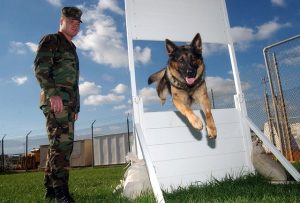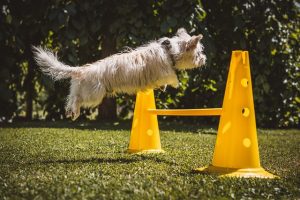How To Start A Career As A Dog Trainer

Have you ever found yourself lost in thoughts about making your love for dogs your full-time job? Well, you’re definitely not alone! Many people share the desire to become a dog trainer. However, it can be overwhelming to figure out where to start. You might be thinking, “How do I even begin?” Don’t worry, though. The most important things in this field are your passion and determination.
By becoming a dog trainer, you’ll have the opportunity to spend your days surrounded by adorable dogs and help pet owners strengthen their bond with their furry companions. In this article, we’ll walk you through what it takes to be an excellent dog trainer and the steps you can take to pursue a successful career in dog training. Let’s get started!
Who Is A Dog Trainer?
A dog trainer is a professional who helps train dogs and learn how to behave and listen to commands. They employ various methods such as positive reinforcement, which involves giving treats or praise to encourage good behaviour. Dog trainers can assist with obedience training, and socialisation, and even teach specific tasks like agility or therapy work. Ultimately, their goal is to ensure that dogs become well-behaved and content companions.
Dog trainers also play a crucial role in empowering individuals with disabilities to live independently by training dogs. In addition to guide dogs for the visually impaired, they also train dogs for various other purposes:
- Dogs for individuals with hearing impairments.
- Dogs for people with physical disabilities.
- Alert dogs that assist individuals with medical conditions, such as detecting epileptic seizures.
What Does Dog Training Entail As A Career?
When we talk about dog training, we’re talking about teaching dogs specific skills and exercises. These exercises can be useful in everyday situations, like walking without pulling on the leash, following commands, playing fetch, and more. In dog training, the trainer guides the dog and sets goals through consistent teaching. The trainer is responsible for training dogs that need it. Nowadays, dog training, along with proper care and upbringing, is considered very important and a growing concern.
During the training, the expert takes care of various tasks. They take the dog for walks to play, run, and attend to its needs. Usually, the owner handles this responsibility. The training session starts in a calm environment without too much noise to keep the dog focused. When the dog successfully follows a command, the trainer rewards it with food and affectionate petting. If the dog makes a mistake, instead of punishment, a simple “No!” is said. It typically entails the following aspects:
- Training Techniques: Using various methods to teach dogs commands, manners, and socialisation skills.
- Behaviour Modification: Addressing and correcting problematic behaviours such as aggression, anxiety, or excessive barking.
- Client Education: Teaching dog owners how to reinforce training techniques and maintain consistent behaviour at home.
- Specialisation: Some trainers specialise in specific areas such as agility training, service dog training, or behaviour rehabilitation.
- Business Management: Running a successful dog training business involves marketing, scheduling, client communication, and record-keeping.
- Physical Requirements: This position may involve physical activity, as trainers need to be able to stay active and manage dogs of different sizes and personalities.
- Patience and Empathy: Working with dogs and their owners requires a high level of patience, understanding, and empathy.
Overall, dog training can be a rewarding career for those passionate about working with animals and helping them become well-behaved companions.
What Will You Do As A Dog Trainer?
Besides understanding the requirements of being a dog trainer, it’s also important to know the tasks they carry out. So, let’s take a look below!
- The primary duty of a dog trainer is to teach dogs to follow commands and adjust their behaviour according to different situations. For instance, dogs that assist individuals with hearing impairments need to be comfortable in noisy environments, public transportation, and other settings. A trainer can familiarise the dog with various sounds like telephones and fire alarms.
- Advanced training may involve teaching a dog how to load a washing machine, fetch items from supermarket shelves, or retrieve an inhaler.
- Trainers assist new dog owners in working with their dogs at home. For example, trainers teach dogs to respond when they hear sounds like an alarm clock or a doorbell by alerting their owners with a paw and guiding them to the source of the sound.
- In addition to training dogs, trainers can also engage in fundraising activities such as organising shows, giving talks at schools, and hosting charity concerts. Some others are as follows;
Assessment
- Evaluate the dog’s temperament, behaviour, and learning style.
- Identify any specific training needs or behaviour issues.
- Consider the dog’s age, breed, and past experiences when assessing training requirements.
Planning
- Develop a personalised training plan tailored to the dog’s unique characteristics.
- Set clear goals and milestones for the training process.
- Consider the owner’s preferences and lifestyle when designing the training programme.
Instruction
- Teach basic obedience commands such as sit, stay, and come.
- Demonstrate proper leash walking and socialisation skills.
- Use effective communication techniques to convey commands and expectations to the dog.
Behaviour Correction
- Address common behaviour problems like jumping, barking, or aggression.
- Implement strategies to modify unwanted behaviours using positive reinforcement.
- Guide how to redirect negative behaviours into more appropriate actions.
Positive Reinforcement
- Use rewards such as treats, toys, and praise to reinforce desired behaviours.
- Consistently acknowledge and reward the dog for following commands correctly.
- Create a positive and encouraging training environment to motivate the dog to learn.
Support
- Offer ongoing assistance and guidance to owners throughout the training process.
- Provide resources and information on dog behaviour and training techniques.
- Address any concerns or questions the owner may have about their dog’s progress or behaviour.
Skills Required By Dog Trainers
Skills needed for a dog trainer usually include:
- Understanding Canine Behaviour: Knowing how dogs behave and think to effectively evaluate and address their training needs.
- Communication Skills: Being able to communicate clearly and effectively with both dogs and their owners to give commands, instructions, and training techniques.
- Patience and Empathy: Having the patience to work with dogs at their own pace and the ability to understand their perspective and motivations.
- Problem-Solving: Being able to identify behaviour issues and come up with appropriate strategies to address them.
- Adaptability: Being flexible and able to adjust training methods based on each dog’s responses and learning styles.
- Positive Reinforcement Techniques: Being skilled in using positive reinforcement methods like treats, praise, and play to motivate and reward desired behaviours.
- Teaching and Coaching: Being able to teach and guide dog owners on how to reinforce training techniques and maintain consistency at home.
- Physical Fitness: Having the physical fitness and stamina to handle and train dogs of different sizes and energy levels, as well as demonstrate training exercises.
- Observational Skills: Having sharp observation skills to assess dog behaviour and monitor progress during training sessions.
- Professionalism: Maintaining professional demeanour and ethical conduct when interacting with clients, as well as being able to keep client information confidential and provide excellent customer service.
Some Dog Training Methods To Know About
There are many ways to train dogs, each with its unique philosophy and techniques. It’s important to know the different options available. Here are a few of the most popular dog training methods:
Positive Reinforcement
Instead of punishing unwanted behaviours, this approach emphasises rewarding desired behaviours. By using treats, praise, toys, or other incentives, positive reinforcement promotes good behaviour and fosters a positive learning atmosphere for dogs. Moreover, it also strengthens the bond between dogs and their trainers.
Clicker Training
Clicker training is a cool way to train your dog using positive reinforcement. It involves using a clicker device to signal when your dog does something good and then rewarding them with a treat. This helps your furry friend understand that the click means they’ve done something right, and it also helps you time the rewards perfectly
Scientific Training
Scientific training is all about using animal behaviour and learning theory to modify behaviour. It relies on evidence-based techniques and focuses on positive reinforcement and rewards. The main goal is to understand the reasons behind behaviour and address them through training.
Dominance-Based Training
This technique centres around making the trainer the “alpha” or leader of the pack and employs methods like physical corrections or punishment to ensure obedience. Nevertheless, this approach has faced backlash due to its potential to instil fear or aggression in dogs, and it is not endorsed by numerous contemporary trainers.
Relationship-Centred Training
Relationship-centred training puts emphasis on establishing a solid connection and trust between dogs and their trainers. It involves comprehending and fulfilling the dog’s needs, utilising positive reinforcement, and encouraging cooperation instead of dominance. This approach prioritises the emotional welfare of dogs and aims to foster a harmonious relationship.
Please remember that the effectiveness of each training method can vary based on your dog’s traits and the specific goals you have for training. It’s a good idea to consult with a professional dog trainer to find the best approach for your beloved pet.
How To Become A Dog Trainer?
To become a certified dog trainer, you need to have a mix of education, practical experience, and a solid grasp of canine behaviour. Although it’s not compulsory, getting certified can boost your reputation and expand your options for jobs or even launching your dog training venture. Here’s a breakdown of the steps to become a certified dog trainer.
Explore And Educate Yourself
Begin your journey by delving into the realm of dog training and acquainting yourself with various training techniques, dog behaviour, and the theory of learning. You’ll find a plethora of books, online courses, and resources that can aid you in expanding your knowledge and comprehension in this domain.
Gain Hands-On Experience
Practical experience is paramount in becoming a proficient dog trainer. Think about offering your services as a volunteer at nearby animal shelters or dog training centres to gain firsthand experience working with diverse dogs. This invaluable opportunity will enable you to observe and learn from seasoned trainers while honing your unique training methods.
Find The Right Certification Programme
Search for reputable certification programmes that match your goals and values as a dog trainer. The Certified Professional Dog Trainer (CPDT) certification from the Certification Council for Professional Dog Trainers (CCPDT) is widely recognised in the industry. You can also explore certification programmes offered by organisations like the International Association of Animal Behaviour Consultants (IAABC) and the Karen Pryor Academy.
Get Through The Coursework
Enrol in a certification programme and complete all the required coursework. This might involve attending classes, workshops, or seminars either in person or online. The coursework usually covers various topics including dog behaviour, training techniques, learning theory, and ethics.
Get Hands-On Experience
Numerous certification programmes mandate a specific amount of practical training hours. You can acquire this by participating in internships, apprenticeships, or working alongside a certified trainer. Practical experience enables you to put your knowledge into action and enhance your skills even further.
Ace The Certification Exam
Once you’ve finished the required coursework and gained the necessary experience, you’ll need to pass a certification exam. The exam usually tests your knowledge of dog behaviour, training methods, and ethical practices. Passing the exam shows that you’re a competent dog trainer and can become certified.
Embark on an enriching adventure as a certified dog trainer by just following these guidelines. Remember that acquiring knowledge and hands-on experience is an ongoing process. It’s essential to stay informed about the most recent research and techniques in the realm of dog training.
Salary And Career Outlook In Dog Training
In India, the monthly salary for a dog trainer can range from INR 10,000 to INR 50,000. The amount you earn depends on factors like your experience, where you work, and the type of services you provide.
Dog Trainer careers have seen a promising job outlook since 2004. The number of available positions in this field has risen by 84 percent across the country, with an average annual growth rate of 5.25 percent. The demand for Dog Trainers is projected to continue increasing, with an estimated 42,070 new jobs being filled by 2029. This translates to a yearly growth rate of 31.52 percent in the coming years.
Going From A Dog Lover To A Dog Trainer
Becoming a dog trainer in India has the potential to be a rewarding and profitable career choice for individuals who adore dogs. By acquiring expertise and hands-on experience with canines, obtaining certification, expanding your connections, and either establishing your venture or joining a dog training company, you can pave your way to triumph as a dog trainer.
Discover Your Potential with Mentoria’s Career Guidance. Whether you’re aiming to excel in your studies, explore new academic paths, or switch to a different field, our mentors will craft a personalised plan for you. Offering various streams, 850+ courses, and insights into 12,000+ careers, we’re here to help you discover your ideal academic fit. Connect with our mentors today to kick-start your journey toward a fulfilling and successful student life.












